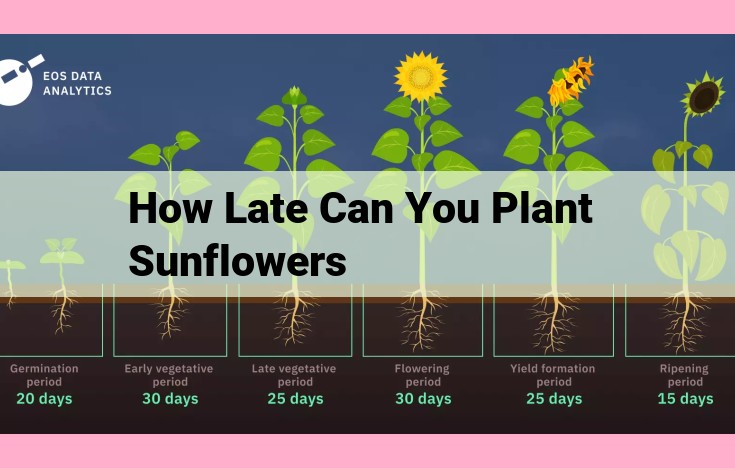When To Plant Sunflowers: An Optimal Timing Guide For Regions

The optimal time to plant sunflowers varies by region, but generally, they should be planted after the last frost date. The last frost date can be found online or at local nurseries. Sunflowers can be planted up to 12 weeks before the first expected frost in the fall.
Planting Guide:
- Sunflower Planting Dates: Optimal time for planting sunflowers in different regions.
- Last Frost Date: Determining the last frost date to ensure ideal planting conditions.
- Planting Depth: Proper depth for seed placement to promote germination.
- Spacing: Distance between plants for healthy growth and optimal yield.
Sunflower Planting Guide: A Step-by-Step Guide for Beginners
Sunflower Planting Dates:
When it comes to planting sunflowers, timing is everything. For optimal results, plant your seeds after the last frost date in your area. This ensures that the soil has warmed up sufficiently and that any potential frost won’t damage your seedlings.
Last Frost Date:
To determine the last frost date for your region, consult a local gardening calendar or the National Oceanic and Atmospheric Administration (NOAA) website. Once this date has passed, it’s safe to start planting your sunflower seeds.
Planting Depth:
When planting your seeds, it’s important to place them at the correct depth. The general rule is to plant them twice as deep as they are wide. For most sunflower varieties, this means planting them about 1-2 inches deep.
Spacing:
Proper spacing between plants is crucial for healthy growth and maximizing yield. Sunflower plants need plenty of room to spread their roots and produce large, heavy flower heads. The recommended spacing for most varieties is 12-18 inches apart.
Sunflower Cultivation: Essential Cultivation Instructions
For an abundant harvest and vibrant blooms, sunflowers demand careful cultivation practices that cater to their specific requirements. Understanding the ideal soil conditions, sun exposure, fertilization techniques, and watering needs is paramount for thriving sunflower plants.
Soil and Drainage
Sunflowers prefer well-drained soil with a neutral pH ranging from 6.0 to 7.5. Heavy clay soils or waterlogged areas can hinder root development and prompt disease issues. Amend the soil with organic matter like compost or manure to improve structure and drainage.
Sun Exposure
Sunflowers are light-hungry plants that thrive when bathed in full sun. A minimum of six hours of direct sunlight per day is essential for optimal growth, bud initiation, and flower production. When planting, select a location with unobstructed sun exposure to maximize their potential.
Fertilization
Sunflowers are moderate feeders, requiring balanced fertilization for healthy development. Apply a general-purpose fertilizer with an NPK ratio of 10-10-10 or a specialized sunflower fertilizer at the time of planting. Avoid over-fertilization, as it can lead to lush foliage at the expense of flower production.
Watering
Sunflowers are relatively drought-tolerant, requiring regular but deep watering. Water deeply once a week, allowing the water to penetrate at least 6 inches into the soil. Avoid frequent shallow watering, as it can encourage shallow root development and make the plants more susceptible to drought stress.
Harvesting Techniques: Gathering Golden Blooms for Maximum Quality and Yield
As the summer sun reaches its peak, the towering stalks of sunflowers proudly sway, adorned with majestic golden blooms. It’s an idyllic sight, but beneath the beauty lies a practical task that ensures the enjoyment of these vibrant flowers—harvesting. The timing and methods employed during harvesting play a crucial role in preserving the quality and maximizing the yield of your sunflower bounty.
Timing the Harvest
The key to successful sunflower harvesting is knowing when the flowers have reached their peak maturity. Observe the flower head closely: the back of the bloom should turn a rich, deep yellow or light brown, and the petals will start to curl downwards. Moreover, the seeds inside the head will have plumped up and darkened to a deep gray or black color. Waiting too long after this point may result in overripe seeds that are challenging to remove.
Methods of Harvesting
There are two primary methods for harvesting sunflowers:
- Hand Harvesting: This technique is ideal for smaller gardens or hobbyists. Gently grasp the flower head at its base and twist it clockwise to detach it from the stalk. Avoid pulling the head straight up, as this can damage the plant.
- Mechanical Harvesting: For large-scale operations, mechanical harvesters can quickly and efficiently cut the heads from the stalks. However, this method requires specialized equipment and may not be suitable for small gardens.
Maximizing Yield
To ensure a bountiful harvest, consider these additional tips:
- Choose a dry day: Harvesting during dry weather prevents the flowers from getting wet and molding.
- Wear gloves: The rough edges of the flower heads can be irritating to the skin.
- Handle the heads with care: Avoid bruising or crushing the seeds, as this can affect their quality.
- Dry the flower heads: Spread the heads out in a warm, dry place for several days to allow the seeds to dry thoroughly before storing them.
By following these harvesting techniques, you can capture the golden bounty of your sunflower crop, ensuring that your efforts bloom into a treasure trove of seeds for culinary delights, bird feed, and decorative masterpieces.